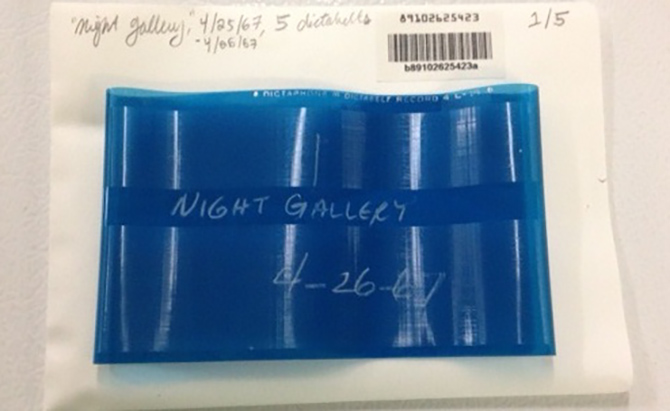 The WCFTR has received a grant of $28,239.60 to digitize 1,152 dictabelts in the Rod Serling collection. This project is supported by a Recordings at Risk grant from the Council on Library and Information Resources (https://www.clir.org/)*. The grant program is made possible by funding from The Andrew W. Mellon Foundation.
The WCFTR has received a grant of $28,239.60 to digitize 1,152 dictabelts in the Rod Serling collection. This project is supported by a Recordings at Risk grant from the Council on Library and Information Resources (https://www.clir.org/)*. The grant program is made possible by funding from The Andrew W. Mellon Foundation.
Rod Serling, an award winning screenwriter, playwright, television producer and author, helped mold live drama in the early years of television with scripts for the anthology series Kraft Theatre, Studio One, The U.S. Steel Hour and Playhouse 90. Best known for his television series The Twilight Zone (1959-1964) and Night Gallery (1970-1973) Serling also wrote screenplays for films including Requiem for a Heavyweight (the television [1956] and theatrical version [1962]) and Seven Days in May (1964) and co-wrote the script for The Planet of the Apes (1968). His made-for-television movies include The Doomsday Flight (1966) and The Strange Case of Dr. Jekyll and Mr. Hyde (1967).
According to the Rod Serling Memorial Foundation, Serling began dictating scripts early in his television career as a way to save time. The practice also probably influenced his writing and mastery of dialogue.
Although many of the scripts documented on the dictabelts have corresponding printed drafts located either in the WCFTR Serling papers or the Serling papers at UCLA’s Special Collections, being able to hear Serling dictate the scripts will provide students and scholars a unique opportunity to analyze his creative process and skill as a writer.
Based on the belts already digitized, Serling didn’t just dictate the dialogue – he also included scene and character descriptions as well. The nuances in his voice and his emphasis on particular words and aspects of the script provide insight into how he envisioned a scene being acted and the story presented – none of which can be gleaned from words on a page. Students and scholars in many disciplines (film, television, creative writing, history, theater) will be able to track the development and revisions of scripts and stories of a highly influential writer in a unique way rarely, if ever, afforded scholars.
 Dictabelts were used by businessmen, doctors, screenwriters, and others to record correspondence, notes, and drafts of screenplays. Their assistants and/or secretaries would then type them up for their review. The belts measure 3 ½ inches wide and 12 inches in circumference and are made of cellulose acetate plastic – one of the types of plastic used for motion picture film. Grooves were impressed into the belts by a stylus and typically held up to fifteen minutes of content. The dictabelts in the Serling collection are still in very good condition but there are signs that deterioration has begun. Digitizing the dictabelts now before any further deterioration occurs will mean fewer condition issues to deal with and the quality of the sound reproduction will be higher. Besides the physical deterioration of the belts, the other crucial factor is the ability to find playback equipment in good working order to digitize them. The last Dictabelt machines were made in the 1970s and it is unknown how much longer the machines that still exist and work will be able to be maintained. The WCFTR will work with Scene Savers to digitize the belts. Researchers will be able to listen to the digitized recordings onsite at the WCFTR.
Dictabelts were used by businessmen, doctors, screenwriters, and others to record correspondence, notes, and drafts of screenplays. Their assistants and/or secretaries would then type them up for their review. The belts measure 3 ½ inches wide and 12 inches in circumference and are made of cellulose acetate plastic – one of the types of plastic used for motion picture film. Grooves were impressed into the belts by a stylus and typically held up to fifteen minutes of content. The dictabelts in the Serling collection are still in very good condition but there are signs that deterioration has begun. Digitizing the dictabelts now before any further deterioration occurs will mean fewer condition issues to deal with and the quality of the sound reproduction will be higher. Besides the physical deterioration of the belts, the other crucial factor is the ability to find playback equipment in good working order to digitize them. The last Dictabelt machines were made in the 1970s and it is unknown how much longer the machines that still exist and work will be able to be maintained. The WCFTR will work with Scene Savers to digitize the belts. Researchers will be able to listen to the digitized recordings onsite at the WCFTR.
*The Council on Library and Information Resources (CLIR) is an independent, nonprofit organization that forges strategies to enhance research, teaching, and learning environments in collaboration with libraries, cultural institutions, and communities of higher learning. To learn more, visit www.clir.org and follow us on Facebook and Twitter.
